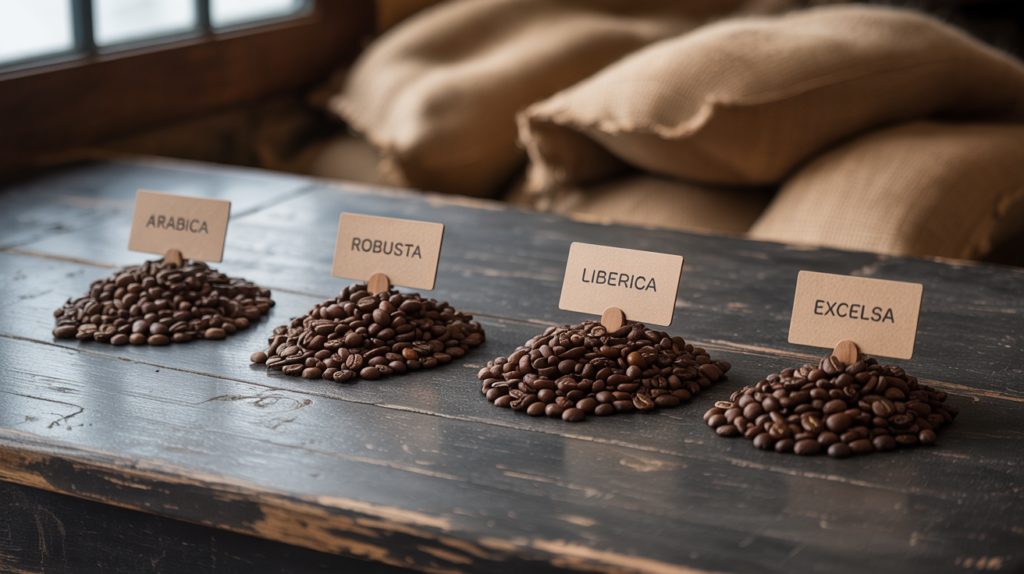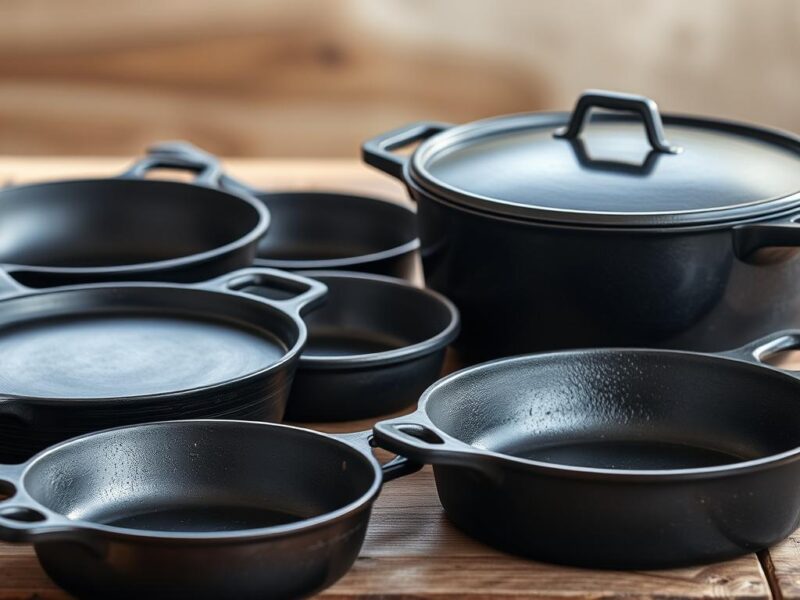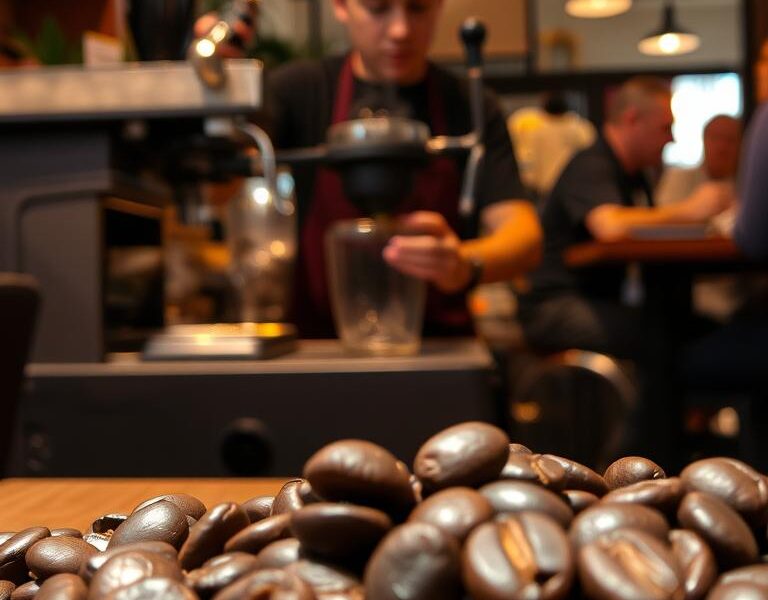Ever wondered why some coffees taste fruity and bright while others are bold and earthy? The secret lies in understanding the different types of coffee beans. While there are countless coffee varieties, four main types of coffee beans form the foundation of every cup you enjoy. Whether you’re a casual coffee drinker or an aspiring home barista, knowing these differences can transform your coffee experience and help you discover flavors you never knew existed.
This post contains affiliate links. If you purchase through these links, I may earn a small commission at no extra cost to you. Learn more here.
In this comprehensive guide, we’ll explore Arabica, Robusta, Liberica, and Excelsa coffee beans – examining their unique characteristics, flavor profiles, and best brewing methods. By the end, you’ll have the knowledge to choose the perfect beans for your morning brew and impress your friends with your coffee wisdom.
From smooth Arabica to bold Robusta, every coffee bean tells a story.☕️ Find out what sets them apart and find your perfect match. Plus, explore premium roasts from The Coffee Bean & Tea Leaf—crafted to bring out the best in every brew.
Understanding Coffee Bean Basics

The four main types of coffee beans: Arabica, Robusta, Liberica, and Excelsa
Before diving into specific bean types, it’s helpful to understand what coffee beans actually are. Despite the name, coffee “beans” aren’t beans at all – they’re the seeds of coffee cherries that grow on coffee plants. These seeds are processed, dried, and roasted to create the coffee beans we recognize.
Coffee plants belong to the Coffea genus, with different species producing distinct bean types. While there are over 100 coffee species worldwide, only a handful are commercially cultivated. The four main types – Arabica, Robusta, Liberica, and Excelsa – make up nearly all global coffee production, with Arabica and Robusta accounting for over 90%.
Each bean type has unique growing requirements, physical characteristics, and flavor profiles that influence everything from cultivation practices to brewing methods. Understanding these differences helps explain why coffees from different regions and varieties can taste so dramatically different.
Arabica: The Smooth Crowd-Pleaser

Arabica beans (Coffea arabica) are the world’s most popular coffee variety, accounting for 60-70% of global production. Originally from Ethiopia, these beans have become the gold standard in specialty coffee for their complex flavors and aromatic qualities.
Growing Regions & Characteristics
Arabica thrives in high-altitude environments with plenty of rainfall and well-drained soil. These plants are relatively delicate and susceptible to disease, making them more challenging and expensive to cultivate than other varieties.
- Top Growing Regions: Ethiopia, Colombia, Brazil, Guatemala, Costa Rica
- Growing Altitude: 600-2000 meters above sea level
- Plant Characteristics: Smaller, more delicate plants requiring specific growing conditions
- Bean Shape: Oval with a distinctive S-shaped center cut
Flavor Profile & Brewing
Arabica beans are prized for their smooth, complex flavor profiles with higher acidity and sweeter notes than other varieties. The flavor can vary significantly based on growing region and processing method.
- Flavor Notes: Fruity, floral, berry, chocolate, caramel
- Acidity: Medium to high
- Body: Light to medium
- Caffeine Content: Lower (0.8-1.4%)
- Best Brewing Methods: Pour-over, drip, French press
Arabica beans shine when brewed as pour-over or drip coffee, allowing their subtle flavor notes to fully develop. Their natural sweetness means they’re excellent when enjoyed black, without cream or sugar.
Robusta: Bold & Caffeinated

Robusta (Coffea canephora) is the second most produced coffee variety globally, making up about 30-40% of world coffee production. As its name suggests, these beans come from a hardy, disease-resistant plant that can withstand harsh growing conditions.
Growing Regions & Characteristics
Robusta plants are significantly more resilient than Arabica, thriving at lower altitudes and in warmer climates. They’re naturally resistant to many diseases and pests thanks to their high caffeine content, which acts as a natural insecticide.
- Top Growing Regions: Vietnam, Brazil, Indonesia, Uganda, India
- Growing Altitude: 0-800 meters above sea level
- Plant Characteristics: Taller, hardier plants with higher yield
- Bean Shape: Rounder with straight center cut
Flavor Profile & Brewing
Robusta beans are known for their strong, bold flavor with pronounced bitterness. They contain nearly twice the caffeine of Arabica beans, contributing to both their bitter profile and their popularity in espresso blends.
- Flavor Notes: Earthy, woody, nutty, chocolate, rubber
- Acidity: Low
- Body: Full, heavy
- Caffeine Content: Higher (1.7-4%)
- Best Brewing Methods: Espresso, moka pot, Vietnamese coffee
While often considered inferior to Arabica in specialty coffee circles, high-quality Robusta beans can offer excellent complexity with chocolate and nut notes. They’re particularly valued in espresso blends, where they contribute to the rich crema and add body and punch to the cup.

Vietnamese coffee typically uses Robusta beans for its strong, bold flavor
Liberica: The Rare Woody Bean

Liberica (Coffea liberica) is a rare coffee variety that accounts for less than 2% of global coffee production. Native to Liberia in West Africa, these beans gained brief popularity in the late 1800s when coffee leaf rust devastated global Arabica production.
Growing Regions & Characteristics
Liberica plants are tall, tree-like species that can grow up to 18 meters in height – much larger than either Arabica or Robusta plants. They produce significantly larger coffee cherries and beans with a distinctive asymmetric shape.
- Top Growing Regions: Philippines, Malaysia, Indonesia, Liberia
- Growing Altitude: Low elevations
- Plant Characteristics: Tall, tree-like plants with large leaves
- Bean Shape: Large, irregular, often with a hook at one end
Flavor Profile & Brewing
Liberica beans offer a highly distinctive flavor profile that polarizes coffee drinkers. Their taste is often described as woody and smoky with floral and fruity back notes, creating a unique cup unlike any other coffee variety.
- Flavor Notes: Woody, smoky, floral, fruity, sometimes described as “forest-like”
- Acidity: Low to medium
- Body: Full
- Caffeine Content: Medium
- Best Brewing Methods: French press, traditional brewing methods
Liberica beans are increasingly rare and difficult to find outside their growing regions. If you have the opportunity to try this unusual coffee variety, it’s worth experiencing its unique flavor profile at least once!
Excelsa: The Mysterious Tart Bean

Excelsa (now classified as Coffea liberica var. dewevrei) was once considered its own species but is now recognized as a variety of Liberica. Despite this reclassification, Excelsa beans maintain distinct characteristics that set them apart from traditional Liberica beans.
Growing Regions & Characteristics
Like Liberica, Excelsa grows on large, robust trees that can reach impressive heights. They’re primarily cultivated in Southeast Asia, where they thrive in similar conditions to Liberica plants but produce beans with different flavor characteristics.
- Top Growing Regions: Vietnam, Philippines, Indonesia
- Growing Altitude: Medium elevations
- Plant Characteristics: Similar to Liberica but with subtle differences
- Bean Shape: Almond-shaped, smaller than Liberica
Flavor Profile & Brewing
Excelsa beans offer a truly unique flavor experience, combining characteristics of both light and dark roasts simultaneously. They’re known for their tart, fruity profile with a mysterious depth that makes them particularly interesting to coffee connoisseurs.
- Flavor Notes: Tart, fruity, dark, mysterious
- Acidity: Medium to high
- Body: Medium
- Caffeine Content: Medium
- Best Brewing Methods: French press, cold brew
Excelsa beans are rarely found as single-origin offerings. Instead, they’re often blended with other bean varieties to add complexity and interesting flavor notes. Their unique profile can add depth to blends without overwhelming the other components.
Coffee Bean Comparison Chart

Visual comparison of Arabica, Robusta, Liberica, and Excelsa beans
| Characteristic | Arabica | Robusta | Liberica | Excelsa |
| Global Production | 60-70% | 30-40% | ~2% | ~7% |
| Caffeine Content | Low (0.8-1.4%) | High (1.7-4%) | Medium | Medium |
| Flavor Profile | Sweet, fruity, floral | Strong, bitter, earthy | Woody, smoky, floral | Tart, fruity, complex |
| Acidity | Medium to high | Low | Low to medium | Medium to high |
| Body | Light to medium | Full, heavy | Full | Medium |
| Best Brewing Methods | Pour-over, drip | Espresso, moka pot | French press | French press, cold brew |
Brewing Tips for Different Bean Types

Different brewing methods highlight the unique characteristics of each bean type
Each coffee bean type has unique characteristics that shine with specific brewing methods. Here are some recommendations to get the most out of each variety:
Arabica Brewing
- Pour-Over: Highlights the delicate floral and fruity notes
- Drip Coffee: Produces a clean, balanced cup
- Aeropress: Brings out sweetness while controlling acidity
- Grind Size: Medium to medium-fine
- Water Temperature: 195-205°F (90-96°C)
Robusta Brewing
- Espresso: Creates rich crema and bold flavor
- Moka Pot: Emphasizes chocolatey notes
- Vietnamese Phin: Traditional method that highlights strength
- Grind Size: Fine to medium-fine
- Water Temperature: 195-205°F (90-96°C)
Liberica & Excelsa Brewing
- French Press: Captures full body and unique flavors
- Cold Brew: Reduces acidity while preserving complexity
- Traditional Methods: Regional brewing techniques
- Grind Size: Coarse to medium-coarse
- Water Temperature: 195-205°F (90-96°C)
Ready to upgrade your brewing setup?
Discover the perfect equipment to bring out the best in your favorite coffee beans.Shop Brewing Equipment
How to Choose the Right Coffee Beans

Selecting the right coffee beans depends on your taste preferences and brewing method
With so many options available, choosing the right coffee beans can feel overwhelming. Here’s a simple guide to help you make the best selection based on your preferences:
If you enjoy smooth, sweet coffee with complex flavors:
Choose Arabica beans from regions like Ethiopia (fruity, floral), Colombia (balanced, nutty), or Guatemala (chocolate, spice). Look for single-origin offerings from specialty roasters for the most distinctive flavor profiles.
If you prefer strong coffee with bold flavor and high caffeine:
Select Robusta beans or Arabica-Robusta blends. These work particularly well for espresso or when you add milk, cream, or sweeteners to your coffee. Quality Robusta can offer interesting chocolate and nut flavors.
If you’re an adventurous coffee explorer:
Seek out the rare Liberica or Excelsa beans for a truly unique tasting experience. These uncommon varieties offer flavor profiles you won’t find in mainstream coffees and make for an interesting addition to your coffee journey.
If you make espresso or milk-based drinks:
Look for espresso blends that combine Arabica and Robusta. The Arabica provides flavor complexity while the Robusta adds body, crema, and punch that stands up to milk. Many Italian-style espresso blends follow this approach.
Remember that freshness matters! Look for beans with a recent roast date (ideally within 2-4 weeks) and always store them in an airtight container away from light, heat, and moisture.
Conclusion: Exploring the World of Coffee Beans

A coffee tasting flight is the perfect way to experience the differences between bean varieties
Understanding the different types of coffee beans is just the beginning of your coffee journey. Each variety offers unique characteristics that can dramatically change your coffee experience. While Arabica and Robusta dominate the market, don’t overlook the opportunity to try Liberica and Excelsa if you can find them.
The best way to truly appreciate these differences is through experience. Consider trying single-origin coffees from different regions and bean varieties to develop your palate. Pay attention to how brewing methods affect the flavor, and don’t be afraid to experiment with different techniques to find your perfect cup.
Remember that there’s no “best” type of coffee bean – only the one that tastes best to you. Your perfect cup might be a bright, acidic Ethiopian Arabica, a bold Vietnamese Robusta, or even a blend that combines multiple varieties. The joy of coffee is in the exploration!
Ready to explore the world of coffee beans?
Explore the world of coffee beans—from smooth Arabica to bold Robusta—and elevate your brew with premium selections from The Coffee Bean & Tea Leaf. Whether you prefer a dark roast or a light blend, discover the perfect match for your palate.


